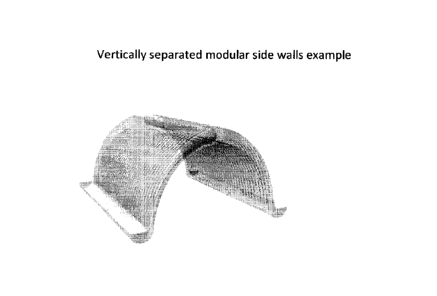Une partie des informations de ce site Web a été fournie par des sources externes. Le gouvernement du Canada n'assume aucune responsabilité concernant la précision, l'actualité ou la fiabilité des informations fournies par les sources externes. Les utilisateurs qui désirent employer cette information devraient consulter directement la source des informations. Le contenu fourni par les sources externes n'est pas assujetti aux exigences sur les langues officielles, la protection des renseignements personnels et l'accessibilité.
L'apparition de différences dans le texte et l'image des Revendications et de l'Abrégé dépend du moment auquel le document est publié. Les textes des Revendications et de l'Abrégé sont affichés :
| (12) Brevet: | (11) CA 3011582 |
|---|---|
| (54) Titre français: | MINI-SERRE A AERATION ET STOCKAGE DE CHALEUR MODULAIRES |
| (54) Titre anglais: | MODULAR HEAT-STORING AND VENTING MINI GREENHOUSE |
| Statut: | Réputé périmé |
| (51) Classification internationale des brevets (CIB): |
|
|---|---|
| (72) Inventeurs : |
|
| (73) Titulaires : |
|
| (71) Demandeurs : |
|
| (74) Agent: | |
| (74) Co-agent: | |
| (45) Délivré: | 2020-01-07 |
| (22) Date de dépôt: | 2018-07-17 |
| (41) Mise à la disponibilité du public: | 2018-12-27 |
| Requête d'examen: | 2018-07-17 |
| Licence disponible: | S.O. |
| (25) Langue des documents déposés: | Anglais |
| Traité de coopération en matière de brevets (PCT): | Non |
|---|
| (30) Données de priorité de la demande: | S.O. |
|---|
L'invention concerne une enveloppe protectrice pour végétaux faite d'un matériau plastique rigide ou semi-rigide translucide ou transparent et qui comprend des parois doubles pouvant accueillir de l'eau ou un autre liquide qui convient au stockage thermique. L'enveloppe implique des éléments modulaires, y compris des parois latérales et/ou d'extrémité qui peuvent être disposées en série. Des surfaces de contact entre les parois peuvent comprendre une courbure. Les parois peuvent être soutenues par une structure indépendante. Les éléments peuvent avoir leur partie inférieure courbée qui collecte le liquide et peut servir de pivot pendant l'aération. L'invention résout les limites d'échelle des enveloppes pour végétaux à stockage thermique passif avec ses parois remplies de liquide. L'invention optimise la rétention thermique des enveloppes protectrices remplies de liquide et offre des rapports hauteur-largeur flexibles. L'invention permet également l'aération passive de telles enveloppes grâce à la convection. Les avantages sont obtenus par les sections modulaires de l'enveloppe, y compris des parois latérales ou d'extrémité indépendantes qui sont divisées verticalement et qui comprennent au moins une surface de contact courbée.
A protective plant cover made from translucent or transparent rigid or semi
rigid plastic
material, comprised of double walls fillable with water or another liquid
suitable for heat storage. The
cover involves modular components including side and/or end walls that may be
placed in series.
Contact surfaces between walls may incorporate curvature. The walls may be
supported by a separate
structure. Components may have a curved bottom that collects liquid and may
act as a pivot during
venting. The invention overcomes scale limitations of passive heat storing
plant covers with liquid filled
walls. The invention optimizes heat retention in liquid filled protective
covers and provides flexible
height to width ratios. The invention also allows for passive venting of such
covers via convection.
Benefits are achieved via modular cover sections, including distinctive side
or end walls divided vertically
and including one or more curved contact surfaces.
Note : Les revendications sont présentées dans la langue officielle dans laquelle elles ont été soumises.
Note : Les descriptions sont présentées dans la langue officielle dans laquelle elles ont été soumises.

Pour une meilleure compréhension de l'état de la demande ou brevet qui figure sur cette page, la rubrique Mise en garde , et les descriptions de Brevet , États administratifs , Taxes périodiques et Historique des paiements devraient être consultées.
| Titre | Date |
|---|---|
| Date de délivrance prévu | 2020-01-07 |
| (22) Dépôt | 2018-07-17 |
| Requête d'examen | 2018-07-17 |
| (41) Mise à la disponibilité du public | 2018-12-27 |
| (45) Délivré | 2020-01-07 |
| Réputé périmé | 2021-07-19 |
Il n'y a pas d'historique d'abandonnement
| Type de taxes | Anniversaire | Échéance | Montant payé | Date payée |
|---|---|---|---|---|
| Requête d'examen | 400,00 $ | 2018-07-17 | ||
| Le dépôt d'une demande de brevet | 200,00 $ | 2018-07-17 | ||
| Taxe finale | 2020-03-27 | 150,00 $ | 2019-11-04 | |
| Taxe de maintien en état - brevet - nouvelle loi | 2 | 2020-08-31 | 50,00 $ | 2020-11-27 |
| Surtaxe pour omission de payer taxe de maintien en état - nouvelle Loi | 2020-11-27 | 150,00 $ | 2020-11-27 | |
| Paiement des arriérés de taxes | 2022-03-07 | 203,59 $ | 2022-03-07 | |
| Paiement des arriérés de taxes | 2022-07-13 | 50,00 $ | 2022-07-13 |
Les titulaires actuels et antérieures au dossier sont affichés en ordre alphabétique.
| Titulaires actuels au dossier |
|---|
| CHAPLIN, CHRISTIE M. |
| Titulaires antérieures au dossier |
|---|
| S.O. |